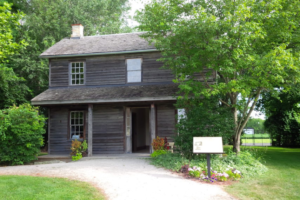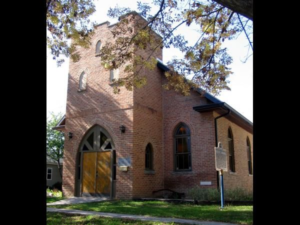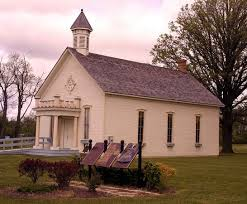Underground Railroad stations in Canada (Southwestern Ontario) :
- Uncle Tom’s Cabin Historic Site – Dresden, Ontario
- Sandwich First Baptist Church – Windsor, Ontario
- Buxton National Historic Site – Chatham, Ontario
- John Freeman Walls Underground Railroad Museum – Lakeshore, Ontario
Uncle Tom’s Cabin Historic Site- Dresden, Ontario
Uncle Tom’s Cabin Historic Site is an open-air museum and African American history centre near Dresden, Ontario, Canada, that includes the home of Josiah Henson, a former slave, author, abolitionist and minister. The site was built on the Black settlement (Dawn Township) that Henson helped found in 1841. The site actually is named from Harriet Beecher Stowe’ s 1852 anti-slavery novel Uncle Tom’s Cabin that included a character “Tom” that was loosely based on Josah Henson. The site was acquired by the Ontario Heritage in 2005. Other buildings on the Dawn Settlement are: Josiah Henson Interpretive Centre, the Sawmill, the Smokehouse, the Josiah Henson House, and the Pioneer Church. 
About Henson:
Josiah Henson was born into slavery but in 1830, along with his wife and four children, he escaped using the Underground Railroad. He eventually crossed the Niagara River into Upper Canada (now Ontario). Henson purchased 200 acres in Dawn Township to build a self-sufficient community for fugitives from slavery. Link: https://nationaltrustcanada.ca/destinations/uncle-toms-cabin-historic-site
Sandwich First Baptist Church -Windsor Ontario
It was built in 1851 on land donated by the Crown. It is one of the many Black border-town churches that existed at the time that were built to serve the increasing numbers of Underground Railroad settlers. This church sheltered and assisted them and all of its members were required to aid in its construction by giving donations or making bricks. “A focal point for many local anti-slavery activities, the Sandwich First Baptist Church stands as an important symbol of that struggle.” (Plaque) 
Description:
Sandwich First Baptist Church was designated a national historic site of Canada in 1999. It is representative of churches in border towns and villages built by black congregations to accommodate the growing communities created by the arriving Underground Railroad refugees. It is associated witht the 19th-centurt establishment of an African Canadian community of refugees from slavery and I one of the oldest Baptist churches surviving from this period in Ontario. Link:https://www.pc.gc.ca/apps/dfhd/page_nhs_eng.aspx?id=1898
Buxton National Historic Site – Chatham, Ontario
The Buxton National Historic Site & Museum, on the original site of the Elgin Settlement, was a “terminal” on the Underground Railroad for fugitive slaves and free Blacks fleeing oppression in the United States It was founded in 1849 by Rev. William King. This Black settlement was renowned for its superior educational system and for becoming a self-sufficient community for approximately 2,000 people. 
Today, it is a museum complex that features three rooms of exhibits, a library and research centre, gift shop, an 1861 schoolhouse, an 1852 log cabin, a replica of the Buxton Liberty Bell, commemorative National Historic Site plaques, a large picnic and playground area and plenty of parking for cars and buses. Several educational programs are available for school groups and their website has many online educational and historic resources on Black history in Canada. Link:http://www.buxtonmuseum.com/education/resources.html
John Freeman Walls Underground Railroad Museum – Lakeshore, Ontario
This historic site commemorates a family chapter in the famous Underground Railroad freedom movement. At the entrance to the John Freeman Walls Historic Site and Underground Railroad Museum, there’s a historic plaque that reads; “In 1846 John Freeman Walls a fugitive slave from North Carolina built this log cabin on land purchased from the Refugee Home Society. This organization was founded by the abolitionist Henry Bibb, published of the Voice Of The Fugitive, and the famous Josiah Henson. The cabin subsequently served as a terminal of the Underground
 Railroad and the first meeting place of the Puce Baptist Church. Although many former slaves returned to the United States following the American civil war, Walls and his family chose to remain in Canada. The story of their struggles, forms the basis of the book “The Road That Led To Somewhere” by Dr. Bryan Walls erected by Proverbs Heritage Organization with the assistance of Maidstone Township and the ministry of culture and recreation.”
Railroad and the first meeting place of the Puce Baptist Church. Although many former slaves returned to the United States following the American civil war, Walls and his family chose to remain in Canada. The story of their struggles, forms the basis of the book “The Road That Led To Somewhere” by Dr. Bryan Walls erected by Proverbs Heritage Organization with the assistance of Maidstone Township and the ministry of culture and recreation.”
Link: https://www.undergroundrailroadmuseum.org/
Bibliography:
- CBC (locations) – https://www.cbc.ca/kidscbc2/the-feed/5-canadian-stations-of-the-underground-railroad
- Sandwich First :https://www.pc.gc.ca/apps/dfhd/page_nhs_eng.aspx?id=1898
- Uncle Tom’s Cabin: https://nationaltrustcanada.ca/destinations/uncle-toms-cabin-historic-site
- Buxton Historic Site: http://www.buxtonmuseum.com/ and https://www.heritagetrust.on.ca/en/pages/our-stories/slavery-to-freedom/partners/buxton-national-historic-site-museum

























